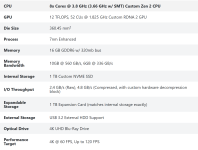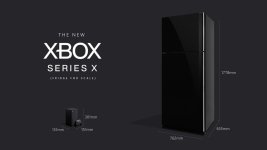Heh, I like the little dig at Sony who seems to be anything but open and transparent with PS5 details.
You are using an out of date browser. It may not display this or other websites correctly.
You should upgrade or use an alternative browser.
You should upgrade or use an alternative browser.
Poll: *** Xbox Series X|S - General Discussion Thread ***
More options
View all postsHibernation file. Just saves the contents of the virtual machine to the SSD.
I'm still undecided whether I'll get a Series X... my current Xbox One X has more or less become an overkill Netflix streaming machine since they launched the Game Pass for Windows.You never know, their interest may have peaked and can't get any higher.
Game Pass for Windows is probably why I'd end up getting the XSX. The installation/management of games is still a crock of manure. Last night I downloaded FFXV and then had no space on the drive to install the 4K pack. So I tried cancelling the download of that - it didn't work. Then I had to move FFXV to a different drive and it didn't like that. So in the end I tried uninstalling everything and it didn't like that! It's a horrible system.
Surprise tech drop from Digital Foundry. Everyone's going nuts. I am just going to read/watch it all now.
https://www.eurogamer.net/articles/digitalfoundry-2020-inside-xbox-series-x-full-specs
https://www.eurogamer.net/articles/digitalfoundry-2020-just-how-big-is-xbox-series-x-really
https://news.xbox.com/en-us/2020/03/16/xbox-series-x-tech/
The only thing I'm wary about is the memory. 16GB to last 7 years? Maybe it's explained in the videos why this is all right but I was expecting 20-24.

https://www.eurogamer.net/articles/digitalfoundry-2020-inside-xbox-series-x-full-specs
https://www.eurogamer.net/articles/digitalfoundry-2020-just-how-big-is-xbox-series-x-really
https://news.xbox.com/en-us/2020/03/16/xbox-series-x-tech/
The only thing I'm wary about is the memory. 16GB to last 7 years? Maybe it's explained in the videos why this is all right but I was expecting 20-24.

Last edited:
Seems like the Xbox will be equipped with 20GB of memory.
No, it's 16GB but DirectStorage (a new part of the DirectX family) allows almost instant access to any game assets. The SSD is like virtual memory.
Yep, that's going to be expensive!
And to add in the extra SSD external cart - £150? Might be better off just sticking to an external HDD and copying everything back and forth.
NVME is much overkill IMO.
I'd rather have 2-3x the space with a SATA SSD and hitting the same price point.
But then the Quick Resume would be Not-So-Quick Resume and the virtual memory stuff would probably be out the window, too.
Jeez, thank god YouTube has a mute button and subtitles.
How is the PS5 going to compare I think I'm in the minority but don't care which I buy, best bang for buck which ever that may be.
Rumoured to be even more TFlops - 13.3
This is from the glossary page - https://news.xbox.com/en-us/2020/03/16/xbox-series-x-glossary/
So you can play 360 and Xbone games from the external USB drive.
Xbox Series X Storage Expansion Card – Built in partnership with Seagate, this 1 TB custom storage solution expands storage capacity of Xbox Series X with the full speed and performance of the Xbox Velocity Architecture. Previous generation Xbox titles can still be played directly from external USB 3.2 hard drives. However, to receive all the benefits of the Xbox Velocity Architecture and optimal performance, Xbox Series X optimized games should be played from the internal SSD or Xbox Series X Storage Expansion Card.
Xbox Velocity Architecture – The Xbox Velocity Architecture is the new architecture we’ve created for the Xbox Series X to unlock new capabilities never-before seen in console development. It consists of four components: our custom NVMe SSD, a dedicated hardware decompression block, the all new DirectStorage API, and Sampler Feedback Streaming (SFS). This combination of custom hardware and deep software integration allows developers to radically improve asset streaming and effectively multiply available memory. It will enable richer and more dynamic living worlds unlike anything ever seen before. It also effectively eliminates loading times, and makes fast travel systems just that: fast.
So you can play 360 and Xbone games from the external USB drive.
Poor design imo.
The weird thing is that the Xbox Series X dev kits are almost identical to the Xbox One X devkits which in turn are almost identical to the Xbox One X console. So I wonder why they didn't stick to that design.
A picture showing the package with 10 GDDR IC’s was released.
Microsoft's solution for the memory sub-system saw it deliver a curious 320-bit interface, with ten 14gbps GDDR6 modules on the mainboard - six 2GB and four 1GB chips. How this all splits out for the developer is fascinating.
"Memory performance is asymmetrical - it's not something we could have done with the PC," explains Andrew Goossen "10 gigabytes of physical memory [runs at] 560GB/s. We call this GPU optimal memory. Six gigabytes [runs at] 336GB/s. We call this standard memory. GPU optimal and standard offer identical performance for CPU audio and file IO. The only hardware component that sees a difference in the GPU."
In terms of how the memory is allocated, games get a total of 13.5GB in total, which encompasses all 10GB of GPU optimal memory and 3.5GB of standard memory. This leaves 2.5GB of GDDR6 memory from the slower pool for the operating system and the front-end shell.
Well I'll be keeping my PC around but don't envisage upgrading it. I'll probably be moving to Apple for general computing (iMac) and buying both next-gen consoles. That should suit me nicely.
Gonna be tricky now having to wait for the XSX version of Cyberpunk 2077.  I'm saving that game.
I'm saving that game.
 I'm saving that game.
I'm saving that game.Fantasy question. If the Xbox APU was availed on a socket what do people think that would be worth?
I'm guessing it costs $199 to make but then mark it up for consumer sales so $299
One looks like a cheap PC with proprietary storage, the other is a proper console.
Looks like is an opinion from yourself but it certainly isn't a cheap PC in reality. There is a boatload of customization in that Xbox.
I'd lean towards XSX purely for the backward-compatibility so I have more titles to play day 1.
I need my fix of Viva Pinata after sooooo many years away.



